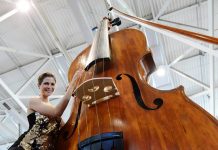
London, UK (Weltexpress). When we talk of horses the word ‘technology’ does not immediately spring to mind. Yet there are two technologies that have been intimately associated with the horse for so long that we overlook their invidious nature and accept them without question: the bit and the horseshoe. The good news is that harmless alternatives to both technologies have now been developed, tested and widely practiced. The bit can be replaced with a cross under design of bitless bridle 1, 2 and with simple management changes a horse can go barefoot.
Invention of the bit facilitated the domestication of the horse, six thousand years ago. Early bits were probably made out of plaited vines, followed by wood, antlers and bone. Metal bits of the Bronze Age were the forerunners of today’s stainless steel bits.
The most ancient of bits are instantly recognizable for what they are and we don’t need an archeologist’s interpretation. The principle and mode of action is unaltered. One or more metal rods are inserted into a horse’s mouth and held in place by means of a bridle. A rein attached to each side of the bit is manipulated by the driver or rider (Fig.1). To this day, most horsemen believe that a bit controls a horse when, in reality, the bit is the most common cause of complete loss of control. Though horses have been bolting, bucking and rearing their way through history, this ‘control’ myth survives all evidence to the contrary.
The horseshoe is a medieval invention. It was in common use by 900 AD and is proudly depicted in the 11th century Bayeux tapestry on the fettered feet of William’s horses. Again, over the ensuing millennium, neither the design nor the principle has changed. A metal hoop is applied to the solar surface of the hoof and fixed in position by a series of nails driven through its wall (Fig.2). Today, most horsemen still believe that the purpose of the horseshoe is to protect the hoof. But evidence gathered in the last 25 years shows this to be incorrect. In fact, shoes cause serious harm to the hooves and ultimately to the whole horse. Properly managed (i.e. neither stabled nor shod) a horse can be used for all the extraordinary purposes that man expects of his ‘best friend’, including hundred mile endurance races over rocky terrain. There is only one exception. Specially designed shoes are still necessary for Western style reining competitions, where (highly unnatural) sliding stops are a required part of a performance. Yet the ‘protection’ myth lives on in all other disciplines.
Persistence of old ideas

As John Maynard Keynes wrote, ‘The difficulty lies not in the new ideas, but in escaping the old ones, which ramify, for those brought up as most of us have been, into every corner of our minds, like the clinging roots of an old juniper.”
Several factors account for a horse still being in irons:
• There are not many technologies in use today that are unchanged since the Bronze Age (bitting) or Saxon times (shoeing), nevertheless, ‘undiscovered crime” is undoubtedly a factor. It was not until the end of the last millennium that the many harmful effects of bitting and shoeing were fully recognized.
• In the absence of an acceptable alternative, bitting and shoeing have been justified as necessary evils. As far as bitting is concerned, it has long been a fundamental assumption on the part of English style riders (though not Western) that there is no alternative to a bit. Similarly, shoes have been regarded as indispensable for serious riding or driving. By definition, as it were, a stabled horse must be shod. It has not been recognized that stabling in the first instance results in the poor hoof quality that now ‘requires’ shoeing to ‘protect’ the hoof.
• Tradition and custom is a potent cause for the persistence of a practice. Horsemen are conservative by nature and tradition alone has become a reason for resisting change. But tradition is not a sufficient reason for maintaining a practice when new knowledge shows that tradition is not consistent with good welfare, i.e. the physiological needs of the horse.

• There is always a time lag between research being completed and results being applied. Passage of a whole generation has not been uncommon. In this age of information, one might hope that such a time lag would not occur over matters concerning equine welfare. Unfortunately committees make rules and regulations and such bodies are vulnerable to what social scientists call a cascade and the problem of mistaken consensus. If one person on a committee ‘gets it wrong’ and is confident enough in his rejection of a new idea, he ‘infects’ others and there follows a cascade of misinformation. But science is not a democracy and the acceptance of scientific advances should be decided on the evidence and not on a majority vote influenced by crowd behavior.
• Finally, there is the ‘not in my back yard’ problem. The introduction of a new idea brings with it an element of the unknown and unfamiliar and this, in turn, raises the spectre of litigation. Administrative bodies are inclined to wait until some other organization has taken the first plunge. Individuals, on the other hand, are more open to new ideas. It is heartening to witness the enthusiasm with which many thousands of riders and drivers have already adopted the bitless and/or barefoot way and are showing by example.
Equine Misery

Rose Macaulay wrote, “Behaviour of such cunning cruelty, that only a human being could have thought of or contrived, we call ‘inhumane’, revealing thus some pathetic ideal standard for our species that survives all betrayals.”
The British Veterinary Association’s Ethics and Welfare Group updated the working definition of ‘animal welfare’ recently as relating “to both the physical and mental wellbeing of the animal.”
The inclusion of mental wellbeing is especially relevant to the horse, a prey animal that – for its evolutionary survival – is dependent upon being easily frightened. My own research has revealed the high degree to which the pain of a bit frightens a horse. It triggers flight, fight and freeze responses that, in man’s environment, are dangerous to both horse and rider. Simply from the point of human safety it is not a good idea to frighten an animal as powerful as a horse. Apart from the fact that a rider loses control of a frightened horse, it is inhumane. The oral cavity is one of the most sensitive parts of a horse’s anatomy. It is inhumane to place a metal rod in a sensitive body cavity and apply pressure.
“To rule with a rod of iron” (or try to) is to rule tyrannically. Interestingly, the manipulation of an instrument (a bit) in a body cavity (the mouth) could be considered an act of invasive surgery. The word ‘surgery’ derives from a Greek word that means, literally, ‘a working with the hands.’ If the bit had never been invented and some scientist today submitted a research grant proposal that involved such ‘surgery’ on a conscious horse, the proposal would be hastily rejected by any reviewing board.

As Noel Coward didn’t say, the bit has a talent to abuse. It is responsible for over 100 examples of negative behaviour, most of which are triggered by pain and fear and some of which are fatal to man and horse. If a medication had half as many serious sideeffects it would be withdrawn from the market. Apart from what might be described as the ‘scared horse syndrome’ the bit causes over 40 different diseases. Physical health is certainly affected as well as mental health (Fig 3). A number of the bit-induced diseases were previously categorized as idiopathic, such as dorsal displacement of the soft palate, epiglottal entrapment and asphyxia-induced pulmonary oedema (‘bleeding’ in racehorses).
The misery caused by shoeing is obvious in different ways but just as serious. Whereas some of the harmful effects of bitting become apparent even on day one after removing the bit, the improvement in welfare after removing the shoes takes time to become apparent. Whereas the bit’s effects are acute in nature, the shoe’s effects are chronic. Shoeing acts like a slow poison. Its effects are cumulative and it may be years before a serious problem surfaces, such as navicular disease or laminitis. The delayed action of shoeing has sheltered it from being discovered as the true cause of these two common scourges. Sadly, because deformity of the hoof by this time is advanced, it can take months or even years before normality can be restored by a barefoot management program (Fig 8). The clinical signs that result from traditional management (i.e. stabling and shoeing) include intermittent or persistent lameness, poor hoof quality, sand cracks, seedy toe, solar bruising, contracted heels, and reduced shock absorption leading to ossification of the lateral cartilages and stress on joints and ligaments. Inability of the hoof to fully dilate and contract with intermittent loading impairs circulation to the foot. It also impairs systemic circulation as healthy hooves act like four supplementary cardiovascular pumps, something that is especially necessary at fast exercise. As with the bit, a clinical sign easily overlooked is inability to carry out the work required and premature death.
Relief of Misery

Replacement of the bit with the crossunder bitless bridle provides painless and more effective rider/horse communication for all disciplines, and for all types, breeds and age of horse (Fig 6). The method is usable by riders of all ages and experience from novice to professional. It enhances a rider’s skills as it encourages the use of seat and legs rather than hands.
Removal of shoes and the institution of a barefoot management program (24/7 turnout and trimming as required when overgrowth occurs) enable a horse to be ridden over all terrains from rock to sand and under all conditions, including ice and snow. Barefoot horses perform to advantage in all disciplines.
Impediments to Relief

There are no contraindications to bitless or barefoot management from equine health or the equestrian’s point of view. The only impediments are of an administrative nature. For example, the Federation Equestre Internationale (FEI) currently mandates the use of one or more bits for the discipline of dressage and for the dressage phases of other disciplines. This brings about the bizarre situation whereby a bit is required for dressage but not for the more dangerous cross-country and show jumping phases of eventing.
National federations follow the FEI lead. The FEI influence even cascades down to Pony Club level, so children with less than perfect hands are obliged to use instruments of torture. As a result, their ponies become ‘hot’ and difficult to handle. The stewards of racing currently require a horse to be raced with a bit. There are fewer administrative rules that require shoes for competitions. But sadly an impediment to the freer adoption of barefoot management programs comes from farriers and our own profession. At present, relatively few veterinarians and farriers have studied the barefoot research. So owners are unable to look to these professionals for help in transitioning their horses from shod to barefoot. This will change in time.
Conclusions

Showing a healthy (unshod) hoof at the end of a 100-mile endurance ride. The horse had completed a 50-mile ride 48 hours earlier. © Photo: Darolyn ButlerThe horse cannot be ‘supplemented’ with steel rods in its mouth and steel hoops on its feet without interfering with its physiological efficiency. It is as though one takes a computer and expects it to work after you have driven a couple of iron stakes through its casing. We ‘supplement’ the horse at our peril. Bits and shoes are weapons of horse destruction. Bitless and barefoot management represents state-of-the-art non-technology. Cruelty has been usefully defined by David Morton as the infliction of avoidable pain and suffering. Now that physiologically compatible alternatives are available to the pain and suffering inflicted by bits and shoes, both of these primitive technologies are now avoidable. Being avoidable, their classification undergoes a sea change. By definition, bitting and shoeing are now cruel practices. It is to be hoped that the administrative bodies of horse sports worldwide will quickly update their rules to bring them into line with these two historic advances in equine welfare.
References
1. Cook, W.R.: Pathophysiology of Bit Control in the Horse. Journal Equine Veterinary Science 19: 196-204, 1999
2. Cook, W.R. and Strasser, H “Metal in the Mouth: The Abusive Effects of Bitted Bridles.” Sabine Kells, Qualicum Beach, BC Canada, 2003
3. Teskey, T.G: ‘The Unfettered Foot: A paradigm shift for equine podiatry.’ J.equine vet sci. Vol. 25, #2 February 2005
4. Strasser H and Kells S: A lifetime of soundness. Sabine Kells, PO Box 44, Qualicum Beach, BC Canada V9K 1S7. 1998
5. Strasser H: Shoeing: A necessary evil? Ed: Kells S. Sabine Kells, PO Box 44, Qualicum Beach, BC Canada V9K 1S7. 1999
6. Cook, W.R.: “Bit-Induced Fear Part 1; From Human Hand to Horse’s Head. Veterinary Times, April 9, 2007, p 18-23.
7. Cook, W.R.: “Bit-Induced Fear Part 2: Bits and Diseases They can Cause.” Veterinary Times. April 30 2007. Vol. 37, No. 15, pp 22,23,25
8. Cook, W.R. “Bit-Induced Fear Part 3, Use of the Bit and Bad Behaviour. Veterinary Times. May 28, 2007.
9. Strasser H and Kells S: A lifetime of soundness. Sabine Kells, PO Box 44, Qualicum Beach, BC Canada V9K 1S7. 1998
10. Strasser H: Shoeing: A necessary evil? Ed: Kells S. Sabine Kells, PO Box 44, Qualicum Beach, BC Canada V9K 1S7. 1999
11. Jackson J: The natural horse. Star Ridge Publishing, Harrison AR 1997
12. Strasser H and Kells S: “Listing of the harmful effects of shoeing.” 2002. Available at www.thehorseshoof.com/listing.html.
13. Cook, W.R.: Tradition and the Status-Quo or Science and Advance?” Veterinary Times, 29th January 2007, p16-18
14. Cook, W.R, Strasser, H, and De Beukelaer, E.R.J.M. (2007) “Compliance with physiology as the foundation for animal welfare guidelines: Exemplified by the rehabilitation of the horse’s foot & mouth.” Animal Welfare 2007 16(S) 166-167

















